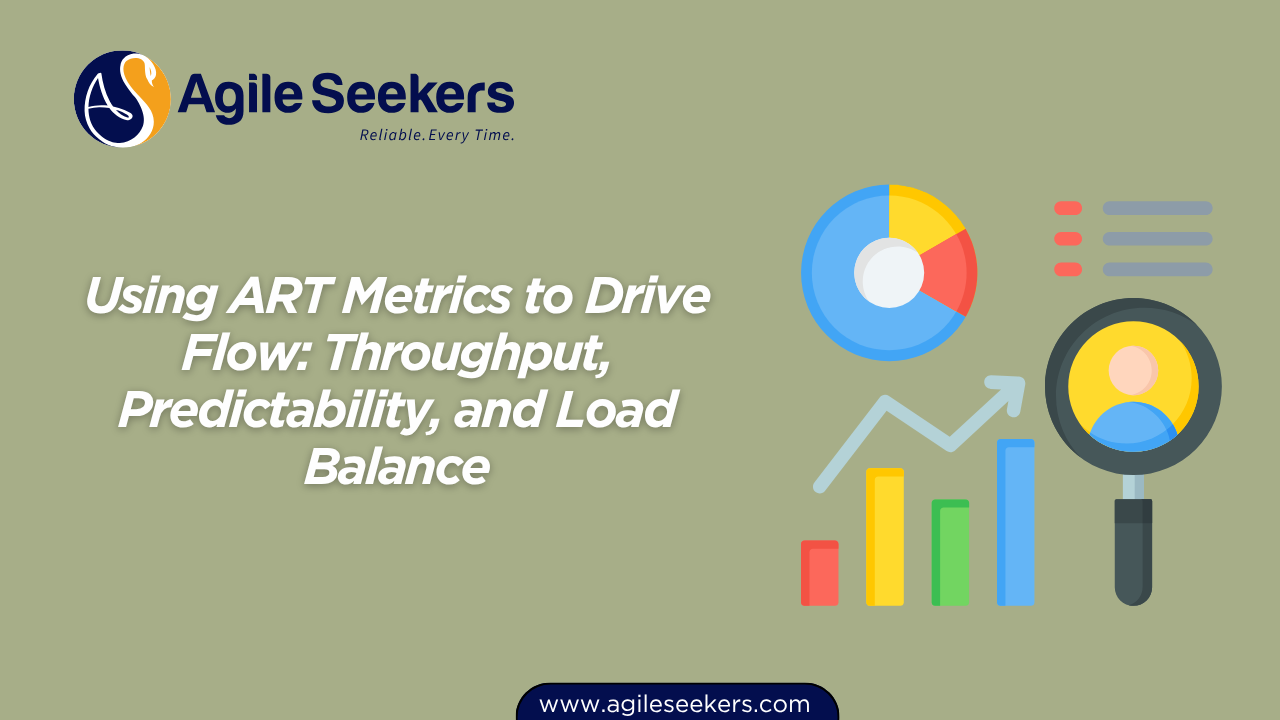Using ART Metrics to Drive Flow: Throughput, Predictability, and Load Balance

Metrics aren't just numbers—they tell a story about how well an Agile Release Train (ART) is functioning. In the Scaled Agile Framework (SAFe), ARTs operate as long-lived teams of Agile teams, delivering value through a continuous flow. To steer an ART toward consistent delivery and alignment with business goals, it’s essential to track and act on specific metrics: throughput, predictability, and load balance. These indicators not only inform performance but also guide improvements and highlight risks before they escalate.
Why ART Flow Metrics Matter
ART metrics are a reflection of system-level performance. They serve as early warning signs and validation points for whether teams are operating at sustainable speed and whether value delivery is aligned with expectations.
Without reliable flow data, assumptions creep into decision-making. With clear metrics, ART leadership—including RTEs, Scrum Masters, Product Managers, and System Architects—can make informed trade-offs across capacity, priority, and delivery timelines.
Flow Throughput: Measuring Output Volume
Throughput is a measure of how many work items (features, stories, or capabilities) are completed over a given period. In the context of ARTs, throughput helps gauge the volume of value delivered sprint over sprint, or PI over PI.
How to Track Throughput:
-
Use tools like Jira, VersionOne, or Azure DevOps to capture story and feature completion.
-
Measure by count, not by story points (as story points are a planning metric, not a delivery metric).
-
Review throughput at both the team and train levels.
How Throughput Helps:
-
Identifies velocity trends—whether the ART is accelerating, plateauing, or declining.
-
Surfaces constraints in the system (e.g., teams that finish work faster than others).
-
Supports SAFe Product Owner/Product Manager (POPM) decisions by helping prioritize work based on proven delivery capacity.
➡ For those aiming to better understand metrics-driven product ownership, the SAFe POPM certification training is a strong foundation.
Predictability: Building Trust in Delivery
Predictability tells stakeholders whether the ART delivers what it committed to. It’s not just about finishing features—it’s about meeting expectations with consistency. In SAFe, predictability is usually measured using the Program Predictability Measure (PPM).
How PPM Works:
-
After each PI, teams assign business value scores to committed objectives.
-
The ratio of actual to planned value scores is calculated.
-
An ART is considered predictable when it achieves 80–100% of its objectives on average.
Why Predictability Matters:
-
Builds stakeholder confidence and trust in the ART.
-
Supports long-term planning and roadmap alignment.
-
Helps Release Train Engineers (RTEs) coach teams toward commitment reliability.
➡ If you're preparing to take ownership of ART-level facilitation and performance, the SAFe RTE certification equips you with tools to improve team-of-teams execution.
Load Balance: Preventing Bottlenecks
Load balance refers to the equitable distribution of work across the ART. Unbalanced workloads cause some teams to become bottlenecks while others remain underutilized. Left unchecked, this leads to delays, burnout, and uneven value delivery.
How to Monitor Load Balance:
-
Visualize WIP (Work in Progress) using a Program Kanban.
-
Track cumulative flow diagrams to identify WIP congestion points.
-
Use capacity allocation across team backlogs to ensure value and enabler work are evenly distributed.
Benefits of Load Balance:
-
Enhances team focus and flow efficiency.
-
Prevents chronic overburdening of high-performing teams.
-
Improves ART-wide collaboration and cross-team support.
➡ Scrum Masters are critical in enabling load balance through proper facilitation and team coordination. Learn more via SAFe Scrum Master certification.
Combining the Metrics for Better Decision-Making
These metrics—throughput, predictability, and load balance—are not isolated. Together, they offer a full view of ART health:
| Metric | Purpose | Risk When Ignored |
|---|---|---|
| Throughput | Gauges volume of delivered value | Unseen drop in team productivity |
| Predictability | Measures commitment vs. delivery | Erodes stakeholder confidence |
| Load Balance | Ensures flow efficiency | Bottlenecks and team burnout |
When reviewed together, these metrics support Inspect and Adapt workshops, enabling structured problem-solving through root cause analysis and actionable improvement items.
How Leaders and Roles Use These Metrics
-
RTEs use flow metrics to synchronize teams, resolve cross-team dependencies, and guide PI execution.
-
Scrum Masters coach teams to reduce WIP, unblock flow, and align with cadence.
-
Product Owners and Managers rely on throughput and predictability to prioritize work that maximizes business outcomes.
➡ The SAFe Advanced Scrum Master certification goes beyond basics, helping Scrum Masters mature into flow facilitators and change agents within ARTs.
External Tools That Support ART Metrics
Modern Agile planning tools offer dashboards to visualize and analyze ART metrics:
-
Flow Framework for enterprise-level value stream measurement.
-
Jira Align for large-scale ART coordination.
-
Azure DevOps for built-in metrics tracking.
These tools allow seamless integration of feature progress, dependency management, and capacity tracking—providing a live view into ART flow dynamics.
Final Thoughts
Flow metrics are not just performance indicators—they're levers for improvement. When an ART begins tracking throughput, predictability, and load balance regularly, it creates visibility, accountability, and continuous improvement.
To succeed in applying these insights, ART members must share a systems-thinking mindset and understand the roles they play across delivery and governance. Certifications like Leading SAFe help leaders build this Lean-Agile foundation and guide enterprise-wide agility.
Want to accelerate your SAFe journey?
Reach out to AgileSeekers or call +91 91 4396 4396 to choose the right SAFe certification aligned with your career goals.
Also Read - Dependency Management in ARTs
Also see - Scaling Product Ownership in ARTs




















